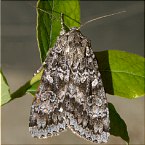Click on the thumbnail pix to see them bigger
Wood Tiger Moth
Parasemia plantaginis
Rusty Tussock Moth
Orgyia antiqua
Spear-Marked Black Moth
Rheumaptera hastata
Herald Moth
Scoliopteryx libatrix
Great Brocade Moth
Eurois occulta

Spear-marked black moths have been very numerous in the Anchorage area
and interior Alaska this year (2004). Larvae feed on birch, and other woody
plants. They can damage vast area in the forests.
There is extensive information about this species at this link.
Herald moths overwinter in the adult form, and are therefore among the first moths flying in the spring--"the herald" of spring. Adults are attracted to sweet fruits. Larvae feed on leaves of alder, aspen, birch, poplar, and willow.
This large attractive moth ranges through North America, Europe and Asia in northern coniferous forests. The larvae feed on a variety of trees and shrubs, but tend to be fairly harmless in most areas of their range. Partially grown larvae overwinter before completing their life cycle.
For more info, try this link.
